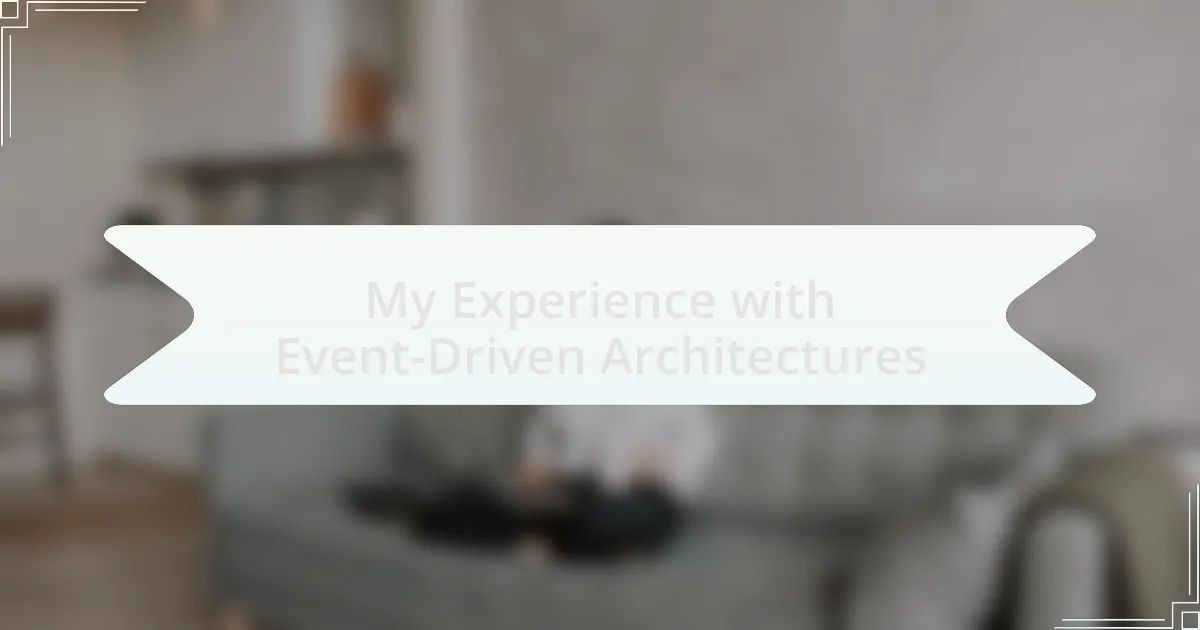Key takeaways:
- Event-driven architectures (EDAs) utilize events as central communication drivers, enhancing flexibility, scalability, and real-time responsiveness.
- EDAs enable the handling of high data volumes with decoupled components, improving system resilience and promoting innovation.
- Choosing appropriate messaging patterns, such as publish/subscribe and request/reply, significantly affects user experience and system performance.
- EDAs encourage agility and continuous improvement, allowing teams to implement changes quickly and make immediate impacts on products.
Author: Oliver Bennett
Bio: Oliver Bennett is an acclaimed author known for his gripping thrillers and thought-provoking literary fiction. With a background in journalism, he weaves intricate plots that delve into the complexities of human nature and societal issues. His work has been featured in numerous literary publications, earning him a loyal readership and multiple awards. Oliver resides in Portland, Oregon, where he draws inspiration from the vibrant local culture and stunning landscapes. In addition to writing, he enjoys hiking, cooking, and exploring the art scene.
Understanding event-driven architectures
Event-driven architectures (EDAs) are designed around the concept of events as the central drivers of communication between different services. This approach connects various components through the production, detection, and reaction to events, allowing flexibility and scalability. I remember my initial project where we implemented an EDA; the real-time responsiveness it provided was thrilling. It felt like we had unlocked a new way of thinking about how applications can interact.
One of the fascinating aspects of EDAs is their ability to handle high volumes of data in real time without direct coupling between components. This decoupling not only enhances resilience but also promotes innovation. I often ask myself: how can we leverage this architecture to create more dynamic applications? In my experience, the answer lies in embracing the potential for asynchronous communication. It allows teams to experiment and iterate faster, resulting in higher-quality software.
As I delved deeper into event-driven architectures, I noticed how they support various messaging patterns like publish/subscribe and request/reply. Choosing the right pattern has a direct impact on user experience and system performance. Reflecting on my past projects, I find that understanding these nuances is vital for designing effective EDAs. How have you approached the challenge of selecting the appropriate messaging pattern in your projects? Each choice can dramatically alter the way components interact and respond, shaping your overall system architecture.
Benefits of event-driven architectures
The benefits of event-driven architectures are extensive, and I’ve seen them firsthand in my projects. One standout advantage is their ability to scale seamlessly. For instance, during a peak traffic period for an application I worked on, our event-driven setup allowed us to manage thousands of simultaneous user interactions without a hitch. It was impressive to witness how adding more services in response to events boosted our system’s performance without overloading it.
Another key benefit is the increased resilience of systems built with event-driven architectures. In one project, we faced a significant service outage due to a dependency failure. Since the components were decoupled, the rest of our services continued to function normally. This experience reinforced my belief that having a system that can gracefully handle failures encourages innovation, as teams can focus on improving individual components without fearing a complete shutdown.
Finally, I’ve found that event-driven architectures foster a culture of agility and continuous improvement. With the real-time feedback loops provided by events, I feel empowered to refine features almost instantly. Have you ever experienced the thrill of deploying a small change and seeing it make an immediate impact? That kind of responsiveness can transform how teams approach development, ultimately leading to more user-centric products.

Leave a Reply